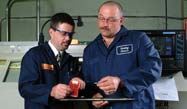Motor Maker Generates Savings With Turning And Milling Tool Changes
For a busy manufacturer of high-efficiency industrial drives, turning and milling a hardened stainless steel motor shaft posed serious productivity challenges.
For a busy manufacturer of high-efficiency industrial drives, turning and milling a hardened stainless steel motor shaft posed serious productivity challenges. Sterling Electric (Irvine, California) found cutting tool changes could increase throughput and slash machining costs on two difficult machining steps. With advanced solid carbide milling cutters, the motor maker increased its productivity better than 800 percent and trimmed milling cost per component around 92 percent. Thanks to wear-resistant cermet turning inserts, the company improved its throughput 16 percent and trimmed turning cost per component 14 percent. Overall, the two-step tooling modernization from Sandvik Coromant (Fair Lawn, New Jersey) generated savings worth about $270,000 during the course of a year.
Sterling Electric designs and manufactures drives for major automakers, breweries, food processors and other industrial users. The plant produces around 30,000 different shafts for standard motor configurations. “We also do a lot of applications where the customer wants a completely oddball shaft made,” plant manager/programmer Harold Barnes explains. One special shaft for a fan motor used in cryogenic laboratories took an unacceptable toll on ordinary cutting tools and costly machining time.
The 22-inch long shaft is made of 17-4PH stainless steel, heat treated to 450 Brinell hardness. Barstock 1 inch in diameter is rough and finish-turned down to 0.6245 inch diameter within 0.0005 inch over 10 inches from each end. While roughing productivity was acceptable with cermet inserts, the finishing cut on the hardened shaft proved especially tough with conventional carbide inserts. “Five tenths is really difficult to hold when your inserts are destroying themselves,” observes Mr. Barnes. Finishing inserts lasted just 30 parts.
“Nothing we had could turn that shaft productively,” recalls Mr. Barnes. “The hardened stainless would actually burn the inserts.” With ordinary carbide inserts, finishing cuts on a Cincinnati Milacron turning center were made at 170 sfm surface speed and 0.0040 inch per revolution feed. The cut took some 4.5 minutes per part. “We were in a trap,” says Mr. Barnes. “Turn too slow, and we’d make no money. Go too fast, and we were literally breaking the edge of the insert off.”
Talks with Sandvik Coromant field representative Dave Verdel suggested tool and process improvements could improve productivity. “I looked at the carbide they were using and saw how the hardened stainless was wearing the tip off. I recommended a more wear-resistant cermet and increased surface footage to reclaim their lost machining time.”
Sandvik Coromant Grade GC1525 titanium based cermet with a thin titanium carbide coating is formulated to maximize edge security when cutting alloyed steels. Based on the manufacturer’s recommendation and his own experience, Mr. Verdel increased surface speed to 320 sfm and feed to 0.006 inch per revolution. The improvement in tool life was dramatic. With four cutting edges, the new cermet inserts produced 540 pieces, where the original carbide inserts were discarded after 30 pieces. Longer tool life meant fewer shutdowns to index and replace inserts.
Equally significant, cutting time per component fell from 4.5 minutes to 1.4 minutes. With non-cutting time unchanged, overall cycle time for finish turning the shaft fell from 23.1 minutes to 19.9 minutes. Throughput per shift increased from 21 to 24 pieces. A 16 percent improvement in finish turning productivity trimmed the cost per component by $3.49. Potential savings over a projected run of 7,500 parts a year would exceed $26,000.
Once turned, the laboratory fan shaft gets a 7-inch long, 3/16-inch wide slot cut in one end on a manually-operated Webb milling machine. Sterling machinists found a single slot cut in the hardened stainless wore their solid carbide endmill cutters under size. A $20 cutter was simply discarded with each shaft. “The material was just too hard,” recalls Mr. Barnes. “It was just eating all of our endmills.” At just 20 sfm cutting speed and 1 ipm feed, slot cutting time was also 11 minutes per shaft.
Sandvik Coromant’s Dave Verdel recommended CoroMill Plura solid carbide endmill cutters with Grade GC1020 coating. Grade GC1020 has a heat-resistant coating. Plura cutters with GC1020 carbide are optimized for stainless steel and hardened alloys up to 48 Rockwell C hardness.
The new cutters made it possible to increase cutting speed from 20 sfm to 343 sfm and boost feed from 1 ipm to 22 ipm. Cutting time fell from 11 minutes to 30 seconds per piece, and total cycle time per component fell from 14 minutes to 1.6 minutes. Production for an 8-hour work shift increased from 34 to 310 parts.
Together, longer tool life and increased throughput on the turning and milling operations will yield productivity improvements worth around $270,000 a year.
Read Next
The Cut Scene: The Finer Details of Large-Format Machining
Small details and features can have an outsized impact on large parts, such as Barbco’s collapsible utility drill head.
Read More3 Mistakes That Cause CNC Programs to Fail
Despite enhancements to manufacturing technology, there are still issues today that can cause programs to fail. These failures can cause lost time, scrapped parts, damaged machines and even injured operators.
Read More
















.png;maxWidth=300;quality=90)




